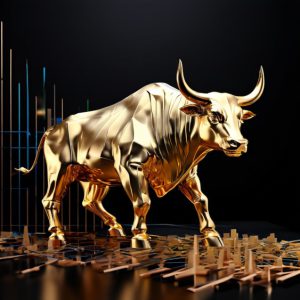
Jan 15, 2024
Harnessing the Market Fear And Greed Index
Introduction:
In investing, emotions often run high. Fear and greed, two powerful psychological forces, can drive market behaviour and influence investment decisions. As investors, understanding and navigating these emotions is crucial for success. Enter the Stock Market Fear And Greed Index, a contrarian tool that harnesses mass psychology to gauge market sentiment. In this article, we delve into the depths of this intriguing index, exploring its intricacies, uncovering its relevance, and equipping you with the knowledge to navigate fear and folly in investing.
Unleashing the Emotional Roller Coaster of Investing
Investing is not just a logical endeavour but also an emotional one, where fear and greed play significant roles in influencing market behaviour. The Fear and Greed Index is a tool that captures this sentiment by combining various market indicators. It helps investors understand the current emotional climate of the market, which can range from extreme fear during downturns to extreme greed in bullish conditions. This index is handy for contrarian investors who seek to identify potential market opportunities by understanding and often going against prevailing sentiment. By providing a clearer picture of the market’s emotional state, the Fear and Greed Index aids investors in making more informed decisions and avoiding common emotional pitfalls that can affect investment outcomes.
Unraveling the Fear and Greed Index: A Deep Dive into Its Core Components
The Fear and Greed Index, a powerful tool in the investor’s toolkit, is a composite of several key indicators that collectively provide a snapshot of market sentiment. This index, often utilized by contrarian investors, offers a numerical representation of the market’s emotional state, ranging from extreme fear to extreme greed. Let’s delve into the three key components that contribute to the nuanced insights offered by this index:
**Volatility Index (VIX)**: The VIX, often called the “fear index,” measures market volatility derived from options pricing. A higher VIX indicates a surge in fear and uncertainty within the market, suggesting that investors may be becoming more risk-averse. Conversely, a lower VIX suggests a more stable market environment characterized by relative confidence and reduced uncertainty. For instance, during the 2008 financial crisis, the VIX reached an all-time high, reflecting the extreme fear and uncertainty prevalent in the market.
**Put/Call Ratio**: This ratio compares the number of put options, essentially bearish bets anticipating a market decline, to call options, bullish bets predicting a market rise. A high put/call ratio indicates heightened fear and a potential downturn as investors lean towards protective strategies. Conversely, a low put/call ratio signals optimism and bullish sentiment, indicating a more positive outlook among market participants. For example, during the Dotcom bubble of the late 1990s, the put/call ratio was meagre, reflecting the market’s bullish sentiment and extreme greed.
**Breadth Indicators**: These indicators provide a panoramic view of market participation by examining the number of advancing versus declining stocks. A wide breadth, characterized by many advancing stocks, signals broad market strength and investor confidence. In contrast, a narrow breadth, where declining stocks outnumber advancing ones, indicates increased caution among investors and potential weakness in the market. For instance, during the market recovery following the 2008 financial crisis, breadth indicators showed a significant increase in advancing stocks, signalling a return of investor confidence and a shift from fear to greed.
Deciphering the Emotional Thermometer of the Market
The Fear and Greed Index is a market sentiment tool that quantifies investor emotions on a scale from 0 to 100, with extreme fear at 0-20 suggesting potentially oversold conditions and buying opportunities, and extreme greed at 81-100 indicating possible overbought scenarios and the risk of market corrections. The index is informed by indicators such as the Volatility Index (VIX), which spikes during market turmoil as seen in the 2008 financial crisis, and the Put/Call Ratio, which reflects investor hedging activities and is notably low during the Dotcom bubble, signalling excessive optimism. Breadth indicators also contribute to assessing the proportion of advancing versus declining stocks to gauge overall market strength. This tool aids investors in identifying market extremes and informing strategic decisions.
Navigating Fear and Greed: Embracing a Contrarian Mindset
Investment strategy is a labyrinth where the contrarian mindset serves as a compass, guiding investors through the tumultuous seas of mass psychology. This technique, which swims against the currents of popular sentiment, is not a rebellious act of defiance but a calculated manoeuvre based on discernment and critical thinking. It is an art that intertwines the wisdom of behavioural economics and the insights of mass psychology, honed by the investor’s understanding.
The Fear and Greed Index, a reliable barometer of market emotions, is a fascinating case study in this context. Historical analysis of this index presents an intriguing narrative of fear-driven declines and greed-propelled ascents. While it provides valuable insights, it is crucial to remember that it is but one piece of the puzzle. The true contrarian sees beyond these emotional waves and identifies the underlying market realities.
A famous example is the 2008 financial crisis, marked by extreme fear. While many investors retreated, contrarians like Howard Marks of Oaktree Capital saw an unprecedented opportunity. By leveraging his contrarian approach, Marks bought high-quality assets that were undervalued due to market pessimism. This strategy, known as “buy low, sell high,” is a hallmark of the contrarian mindset, which views fear as an opportunity rather than a threat.
On the other hand, periods of over-exuberance, such as the Dotcom bubble of the late 1990s, often blind investors to risks. Renowned contrarian Warren Buffett was conspicuous by his absence in tech stocks during this period. Adhering to his risk management philosophy, Buffett stayed clear of technology investments, even as greed drove the market to unsustainable heights. His prudence paid off when the bubble burst, ruining many high-flying tech stocks.
Long-term perspective is another cornerstone of the contrarian approach. John Maynard Keynes, the influential economist, put it succinctly when he quipped, “In the long run, we are all dead.” It is a reminder that short-term market fluctuations, driven by fear and greed, are temporary. The contrarian investor, like Benjamin Graham, the father of value investing, focuses on the intrinsic value of investments. He believed that price is what you pay, but value is what you get, a mantra guiding generations of contrarian investors.
The contrarian mindset is a strategic navigation tool that allows investors to exploit market inefficiencies resulting from irrational fear or exuberance. It is a testament to the wisdom of “buying low and selling high” and a call for a thoughtful evaluation of market conditions. Contrarian investors, armed with their insight and resilience, chart a path that diverges from the crowd, positioning themselves for success in the ever-evolving world of finance.
The investment world is often a theatre where fear and greed perform a never-ending dance. Embracing a contrarian mindset offers investors a seat in the director’s chair, allowing them to orchestrate their financial journey with foresight, prudence, and resilience. It is a prized quality that empowers investors to avoid emotional pitfalls and align their decisions with long-term financial goals.
The Limitations of the Fear And Greed Index
While a helpful sentiment indicator, the Fear and Greed Index has its limitations. It captures the market’s prevailing mood but doesn’t account for all market dynamics. For example, it may not fully reflect fundamental factors like a company’s financial health or broader economic performance, which are critical for thorough investment analysis.
The index’s reliance on emotional sentiment means it can’t predict market trends influenced by economic indicators, industry developments, or global events. Geopolitical events, in particular, can significantly impact markets, often beyond what sentiment indicators can measure.
Historically, the index has shown its limitations during significant events. For instance, during the 2008 financial crisis, the index indicated extreme fear but couldn’t predict the crisis’s duration or subsequent recovery. Similarly, during the Dotcom bubble, the index reflected high levels of greed, but it couldn’t foresee the bubble’s burst or the following market correction.
Investors should use the Fear and Greed Index as one of several tools, combining it with fundamental analysis and other technical indicators to make well-rounded investment decisions.
Conclusion: Mastering the Art of Navigating Fear and Folly in Investing
Understanding and navigating the impact of fear and greed is crucial in the complex investing world. The Fear and Greed Index is a vital tool, providing investors with a numerical measure of market sentiment. This index can help uncover potential investment opportunities and identify market turning points, providing a valuable guide in the ever-shifting landscape of market emotions.
A classic example of the index’s utility was during the 2008 financial crisis. The index hit extreme fear levels, indicating a market oversold due to panic and uncertainty. Contrarian investors, viewing this as a potential buying opportunity, could have capitalized on the subsequent market recovery.
However, investing is not purely driven by emotions or sentiment analysis. Fundamental analysis, considering earnings, dividends, and overall economic performance, remains a cornerstone of prudent investing. While insightful, the Fear and Greed Index should be used with other tools and analyses for a comprehensive investment strategy.
The index also encourages a contrarian mindset, prompting investors to question prevailing market sentiment and identify potential market mispricings. For instance, during the Dotcom bubble in the late 1990s, the index reflected high levels of greed, suggesting a market overbought due to excessive optimism. Contrarian investors could have viewed this as a signal to take profits or adopt defensive strategies in anticipation of a market correction.
In conclusion, while a powerful tool, the Fear and Greed Index is just one part of a holistic investment strategy. It aids in understanding market sentiment, but the investor’s interpretation and application of this information, combined with other analytical tools, can lead to robust decision-making in the ever-evolving world of finance. Mastering the balance between fear and greed is not merely a skill but an ongoing process requiring resilience, adaptability, and a keen understanding of market dynamics.
Immersive Insights: Deep-Dive Articles

Mastering Options Trading: Unveiling the Real Secrets

Which of the Following Is an Example of Collective Behavior?

4X ETF: Deadly Risks and Realities

SPY 200-Day Moving Average Strategy: Learn, Earn, and Prosper

Best Tech Stocks To Buy Now: Spotting the Trend

CPNG Share Price: Buy, Sell, or Hold?

Rolling Over Options: The Ultimate Guide to Mastery

Fearless Finance: Harnessing Stock Market Fear for Contrarian Victories

Market Timing Strategies: Debunking Flawless Predictions

Dow 30 Stocks with Dividends: A Winning Strategy for Income Investors

Collective Behavior Generally Takes Which of the Following Forms?

Harnessing Collective Behavior: Strategies for Investment Success

Unlocking Value in Equal-Weighted Index Funds: Benefits and Strategies

What Caused the 1987 Stock Market Crash: Could It Happen Again?

Active vs Passive Investors – The Power of Discipline
Harnessing Collective Behavior: Strategies for Investment Success


